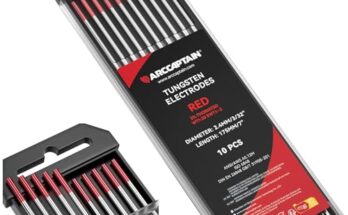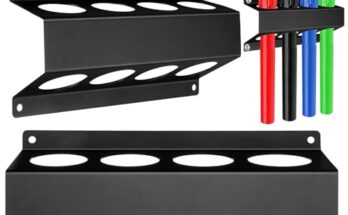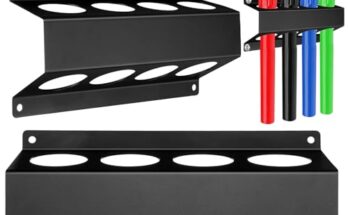I still remember the first time I struck an arc with a 2% thoriated tungsten electrode. The puddle lit up bright and steady, like a tiny sunrise clamped between my fingers. From that moment, I understood why generations of welders have sworn by the little red‑tipped rods.

Photo by stahlwerk-schweissgeraete
I’ll walk you through every corner of the subject—from what thorium actually does inside the alloy to where, when, and why I still keep a box of thoriated tungstens on my bench. Grab a fresh cup of coffee and let’s dive in.
Chemistry Behind the Red Tip
Thoriated tungsten is simply tungsten infused with thorium oxide. The most common blend is WT20, which means 98 percent pure tungsten and 2 percent thorium oxide by weight. That small dose of thorium raises the electrode’s electron‑emission rate.
In plain English, the arc starts easier and stays narrower. The metal at the tip resists wear, so you don’t have to re‑grind every ten minutes.
Thorium itself is a weakly radioactive metal, which sounds scary until you remember it’s less active than the tiles in many old bathrooms. Even so, we handle the dust with care and use a dedicated grinder. I’ll share practical safety steps later.
Why Welders Fell in Love With Thoriated Electrodes
Back before inverter machines took over, scratch‑start TIG rigs needed an electrode that would light almost on command. Thoriated tungsten answered that call.
It performs best on DC‑enriched currents where the electrode runs negative. Think carbon steel, stainless, chromoly, nickel alloys, titanium. For those metals, thoriated still feels like the gold standard for:
- Reliable hot starts. One tap and the arc jumps without sticking.
- Tight arc column. A focused stream lets me weld razor‑thin edges without wander.
- High amperage capacity. WT20 survives 20 percent more amps than pure green tungstens of the same size.
- Long grind life. The thorium keeps the tip geometry sharper for longer sessions.
How I Choose Electrode Diameter
I keep four diameters in the drawer: 0.040″, 1⁄16″, 3⁄32″, and 1⁄8″. The rule of thumb below rarely fails me:
| Diameter | Amperage Range (DC‑) | Typical Job |
|---|---|---|
| 0.040″ | 5–30 A | Razor‑thin stainless sheet, instrument tubing |
| 1⁄16″ | 20–90 A | Bike frames, exhaust merge collectors |
| 3⁄32″ | 80–180 A | ⅜‑inch plate, food‑grade tanks |
| 1⁄8″ | 150–300 A | Heavy structural pipe, thick titanium |
If I flirt with the top of each range, I switch to a larger rod rather than push the tip into meltdown. That habit alone has saved me hours of re‑grinding.
Common Welding Applications
Pressure‑Vessel Fabrication
Boiler code loves consistency. Thoriated tungsten delivers repeatable weld profiles on thick-wall chrome‑moly tubes. The narrow arc digs deep, but I can still feather the toes without undercut.
Aerospace Tooling
Whenever I build titanium purge fixtures or nickel super‑alloy brackets, I stick with WT20. The electrode holds a point for the entire root pass, which matters when the joint sits above my head and I can’t stop to grind.
Nuclear Piping—Yes, With Precautions
Ironically, even some nuclear plants allow thoriated electrodes on stainless runs because the weld integrity outweighs the minor radiation risk.
Strict dust‑control rules apply. I wear nitrile gloves and capture grindings in a sealed shop‑vac fitted with a HEPA filter. Waste goes into a marked container for pickup.
Custom Motorcycle Frames
Chromoly loves a crisp arc. I TIG those long gussets with 1⁄16″ thoriated at 70 amps. The bead wets nicely without wandering off the tight radius.
Comparisons With Modern Alternatives
Lanthanated (Blue Tip). Great all‑rounder for AC and DC. Arc starts rival thoriated, but at very high amps the tip can ball up sooner.
Ceriated (Orange Tip). Fantastic at low amps—micro‑welding razor blades or razor‑thin foils. It wears down quicker under heavy load.
Multi‑mix Rare‑Earth (Purple). Strong contender; some brands claim it outperforms all others. I like it on inverters, but on an old transformer set, thoriated still feels more predictable.
Pure Tungsten (Green). Only when I’m welding aluminum on a sine‑wave AC machine. Otherwise pure tungsten is like driving a 1970 pickup without power steering after tasting a modern sports car.
Grinding and Tip Geometry
I grind lengthwise on a dedicated diamond wheel, 2‑inch width, medium grit. The angle depends on amperage:
- Small electrodes (≤1⁄16″): 25‑degree included.
- General purpose (3⁄32″): 35‑degree.
- Heavy rods: 45‑degree to avoid tip sloughing.
I finish with a tiny land at the apex. That flat—no wider than the line of a fine Sharpie—prevents crater cracks at arc start.
Remember to grind so the lines run parallel to the length. Circumferential scratches collect tungsten vapor and spit it into the puddle, causing weird green freckles.
Radioactivity and Safe Handling
Thorium emits alpha particles. Those can’t penetrate a sheet of paper, but the dust matters. My four golden rules:
- Local exhaust. A goose‑neck fume arm hovers by the grinder.
- Wet wipe, don’t blow. Compressed air scatters dust everywhere; a damp microfiber cloth traps it.
- Keep food zones sacrosanct. No electrode work on the snack bench.
- Dispose of stubs right. Metal recycling centers often collect low‑level thorium dust. I label the jar “WT20 GRINDINGS—Do Not Open.”
Follow these and your exposure stays far below background radiation from a weekend hike at altitude.
Beyond Welding—Other Uses of Thoriated Tungsten
While welding is the star act, thoriated tungsten shows up elsewhere:
- Plasma cutting electrodes inside heavy industrial torches.
- Ion thrusters on certain satellites—the high electron emission helps ignite xenon plasma.
- X‑ray tube cathodes in older medical imaging gear.
- Mass‑spectrometer ion sources where stable emission keeps the beam consistent for hours.
The same property welders enjoy—easy electron flow—drives each application.
How to Store and Track Electrodes
I keep mine in a labeled PVC tube with desiccant packs. Each rod wears a color‑coded shrink tube at mid‑length. When the tip shortens to that marker, I toss the stub in the disposal jar. Simple, visual, no guesswork.
Troubleshooting Arc Issues
- Arc wandering: Check for contamination. Dress the tip, clean the work clamp connection.
- Tip splitting: Amperage too high or grind angle too sharp. Increase electrode diameter or blunt the point slightly.
- Green flicker in puddle: Tungsten shedding into weld. Re‑grind with longitudinal scratches only.
Personal Anecdote: Field Repair in Wyoming
A rancher once called me to TIG a cracked hydraulic cylinder on his combine. Power came from a rattly generator, the wind cut across the prairie like a freight train. I grabbed 3⁄32″ thoriated because I knew it would strike even if voltage sagged.
Three beads later, the cylinder was sound, and the rancher handed me a steak the size of a hubcap as thanks. I still doubt another electrode could have saved that day so smoothly.
Environmental Considerations
While thorium is naturally occurring, mining and refinement pose ecological questions. Many shops now test alternative tungstens.
I run experiments too, but until a substitute matches thoriated electrode life and arc focus on thick DC jobs, I’ll keep both options in stock and use each where it shines.
Conclusion
Thoriated tungsten is more than a red‑painted stick in a cup—it’s a proven workhorse that earned its place through decades of dependable performance. From pressure vessel shops to back‑alley bike builders, it lights easily, stays sharp, and handles serious amperage without flinching.
Respect the dust, follow smart safety habits, and this electrode will reward you with silky beads and fewer trips to the grinder. That is why, even in an age of miracle alloys, I still reach for WT20 when the job demands old‑school reliability. Try it on your next DC weld, feel the difference, and decide for yourself.
Frequently Asked Questions
Is thoriated tungsten legal to use in the United States?
Yes. OSHA allows it if workplaces manage grinding dust and follow radiation‑safety guidelines.
Can I weld aluminum with thoriated tungsten?
You can, but lanthanated or rare‑earth electrodes perform better on AC because they resist tip‑balling.
How often should I replace a thoriated electrode?
When the tip becomes too short to grind safely or shows deep nicks you can’t dress out. Many welders retire a rod after it loses one‑third of its original length.
Does thorium in the weld itself pose a hazard?
Almost none. The electrode erodes minimally, and any thorium that enters the puddle is bound inside the solid metal, emitting negligible radiation.
What size grinder wheel is best?
A 6‑inch diamond wheel on a low‑RPM dedicated sharpener works well. Bigger wheels give a smoother finish and less curvature across the grind lines.
Can I store thoriated electrodes with other types?
Yes, but label everything. Separate tubes prevent mix‑ups and keep your procedural specs accurate.
Are thoriated electrodes compatible with inverter welders?
Absolutely. Inverters often have hot‑start functions that make thoriated light even faster, although multi‑mix electrodes can match it on some machines.







